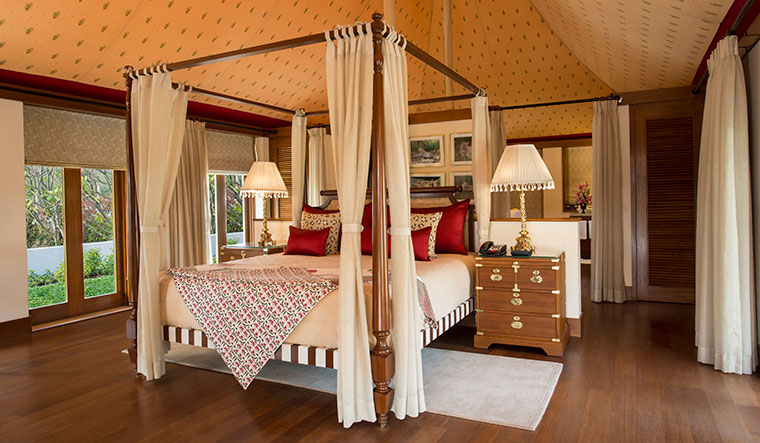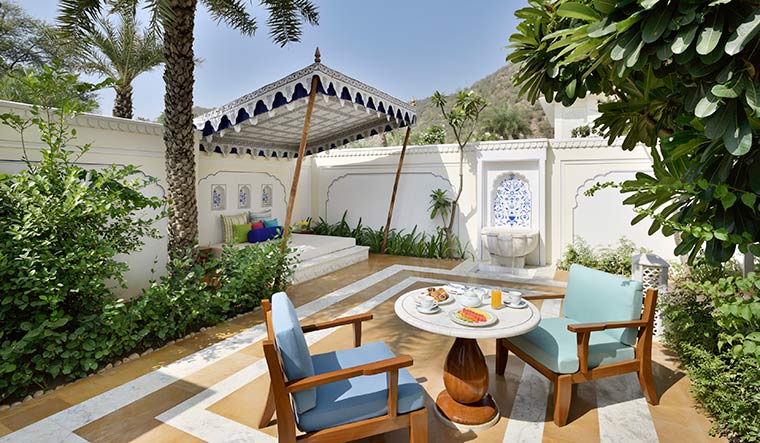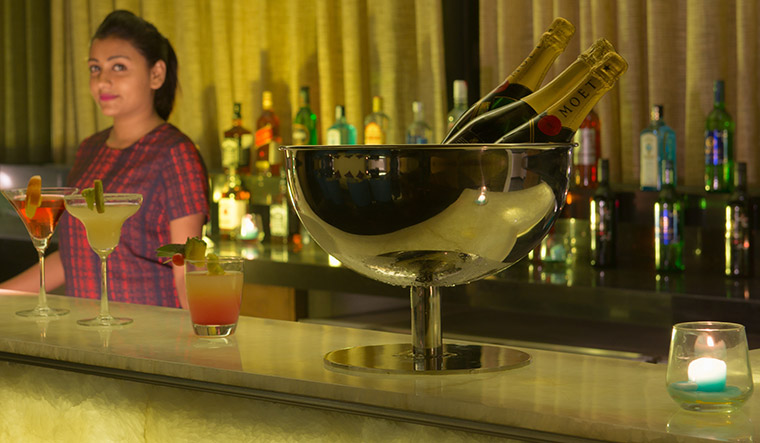At first glance, the lobby of the recently launched The Den in Bengaluru looks like any five-star reception area. But stroll around, beyond the comfy and stylish chairs and chic light installations, and you notice elements you do not normally find in a metropolitan luxury hotel. The staff bustle about in dapper tunics and jeans (you read that right), while a gaming zone with 80 digital games, from Pacman to VR titles, occupies pride of place at the ground level. Right next to a separate Xbox section is The Cave, a 15-seat cinema where guests can have food and drinks while they enjoy a flick.
“Our concept was to create a vibe out there, beyond having just a bar and a restaurant [like in all hotels],” says Vinesh Gupta, The Den’s general manager. “Millennials are travelling [so] much, [and by millennials I don’t mean] being 25 or 28; it is also a thought process. And these are the elements which imbibe the millennial culture and spirit. It is all about [giving a] superlative experience to the customer.”
Luxury is being redefined as an unprecedented number of high-end hotels open up across India—in a hurry, perhaps, to capture the zeitgeist of an economic recovery in the air. From international chains like Marriott-Starwood to traditional heavyweights like The Oberoi and new entrants like The Den, 2018 was the year of boom in hotel launches in the premium segment.
The Marriott group, which merged with Starwood Hotels to become the biggest hotel chain in the world, became a harbinger of the trend when it launched its first W hotel in India in 2017—on a cliff overlooking the sea in Goa. W is the group’s five-star, designer deluxe brand. And, in the past two decades, W has reinvented the luxury game by focusing on frills and spills that the post-1990, ‘excess all areas’ generation yearns for. A fine-dining restaurant with live piano and liveried serving staff? Yeww! A tony nightclub with velvet rope, LED strobe lights and bottle service? Kewl! That, in a nutshell, encapsulates the W principle.
Hotel launches picked up pace after 2018 dawned. Marriott, of course, has been the most prolific—it now has 21,000 rooms in India, spread across more than 100 hotels in 32 cities. Half of the company’s 30 brands are present in the country, with some of the top ones like JW Marriott (Jaipur) and Sheraton Grand (Bengaluru and Chennai) being among 20 new properties launched, or slated to be launched, before year end. This will include a Tribute in Kochi and a Delta by Marriott in Goa.
Others have picked up the pace as well. Hilton followed up its uber-luxury Conrad Pune with one in Bengaluru last year. The Hyatt group, after launching its designer luxury brand Andaz in Delhi (a challenger to W), opened Grand Hyatt Bolgatty in Kochi, a waterfront property with a helipad and an international convention centre. AccorHotels, another big international chain which opened its business hotel Novotel in Kochi, announced that it would bring its legendary Raffles and Banyan Tree brands to India. The first Raffles will open in Udaipur this year, while it is not clear when and where India will get its first Banyan Tree property. (Banyan Tree had to pull out of an island resort project in Kerala a few years ago.)
The traditional biggies of India’s luxury hotel sector are not far behind. Last January The Oberoi relaunched its flagship property in Delhi after a 21-month renovation, and followed it up with an addition to its super-luxury ‘vilas’ portfolio by opening the Sukhvilas, which is nestled in a forest outside Chandigarh. ITC came up with the grand ITC Kohenur in Hyderabad’s Hitec City, while the homegrown Azaya, from the family that runs several Hyatt properties across the country, launched its first property—a beach resort in Goa.
The flurry of launches has been spurred by positive projections in the luxury segment of the market. According to a CARE Ratings study, the availability of rooms in branded hotels is expected to go up by a massive 50 per cent in the five-year period leading up to 2021—from 1.13 lakh to 1.70 lakh. Jean-Michel Casse, chief operating officer (India and south Asia) of AccorHotels, points to “the highest occupancy levels seen in over a decade” behind the optimistic outlook.
Spurring the occupancy levels is a sudden jump in the number of domestic tourists, who are travelling more frequently, spending more and wanting newer experiences. Just four years ago, Indian tourists accounted for just 30 per cent of leisure guests in luxury hotels. Today, half the guests are Indians.
“Increasing income levels, a positive economic outlook, availability of low-cost airlines and increased domestic travellers have all contributed to the revolution,” says Casse. According to the Union tourism ministry, domestic leisure travel increased by more than 15 per cent in 2016 to 10.6 crore. Says Ronen Nissenbaum, CEO of the Dan group, an Israeli hotel giant and parent company of The Den: “With the tremendous growth of the middle class and the wealthy in India, there is going to be far more people who can afford luxury. India is in the right place at the right time with the right growth trajectory.”
With Indians wanting bang for every buck they spend, hotels are searching for the unique selling point that can put them ahead of the competition. A run-of-the-mill hotel with room service and all-day dining (the new term for coffee shops) just will not work anymore. “It is important for every hotel to have a story of its own,” says hotel consultant Jaspreet Singh, who recently launched Delhi’s Andaz by Hyatt and Goa’s Azaya Beach Resort. “The guests need to be intrigued.”
More often than not, the location of the property, local legends and curated experiences bring in this ‘story’ factor. Most hotels now curate trips to popular local attractions, like Novotel Kochi’s early morning trips to the spice markets of Mattancherry or JW Marriott Jaipur’s offer of a chance to visit a nearby elephant village and bathe the tuskers. Andaz’s all-day dining restaurant has a food-hall concept, with counters spread all across serving healthier variants of popular dishes—like biryani made of millets instead of basmati rice.
Even the big chains, traditionally proponents of the cookie-cutter format, have realised the demand for uniqueness. JW Marriott Jaipur, for instance, resembles a Rajput palace dappled in white, replete with water bodies and summer canopies. ITC Kohenur’s facade is shaped like a diamond, with elements of Hyderabad in general and the Nizams in particular reaching out to the guest from every corner of the hotel. The big chandelier in the lobby is made out of hundreds of Hyderabadi bangles, while vintage photos of the city adorn corridors and banquet rooms.
Private plunge pools are an increasingly popular feature, as Indians tend to spend a lot of time in their rooms and love splashing about in pools. Both Azaya and JW Marriott Jaipur feature private pools. The latter takes the cake when it comes to unique fine dining options: At Mohan Mahal, Marriott’s traditional Rajasthani fine dining restaurant, the light from hundreds of candles bounces off thousands of tikri mirrors all over the royal banquet hall-like room, replete with a water body crisscrossing it and a fountain in the middle!
Luxury hotels have spared no expense in setting up unique add-on features that impress guests. The Oberoi Sukhvilas, for example, is surrounded by the 8,000-acre Siswan forest. Guests can experience its ‘forest bathing’ therapy, a de-stress exercise that involves meditating deep in the forest. The USP of the Delhi property of The Oberoi is the industrial-grade air purifiers whirring inside, which has its communications head Silki Sehgal gleefully exclaiming, “The cleanest air you can breathe in this town!”
The air is suffused with optimism, as more luxury hotels are expected to open their doors in the coming months. “As you become more successful in your business and grow your wealth, you automatically aspire for more,” says Nissenbaum. “[So] there is going to be a lot more people who can afford luxury. They may only be [part of] the 10 per cent, but there is always people moving up from the remaining 90 per cent to this 10 per cent.”





